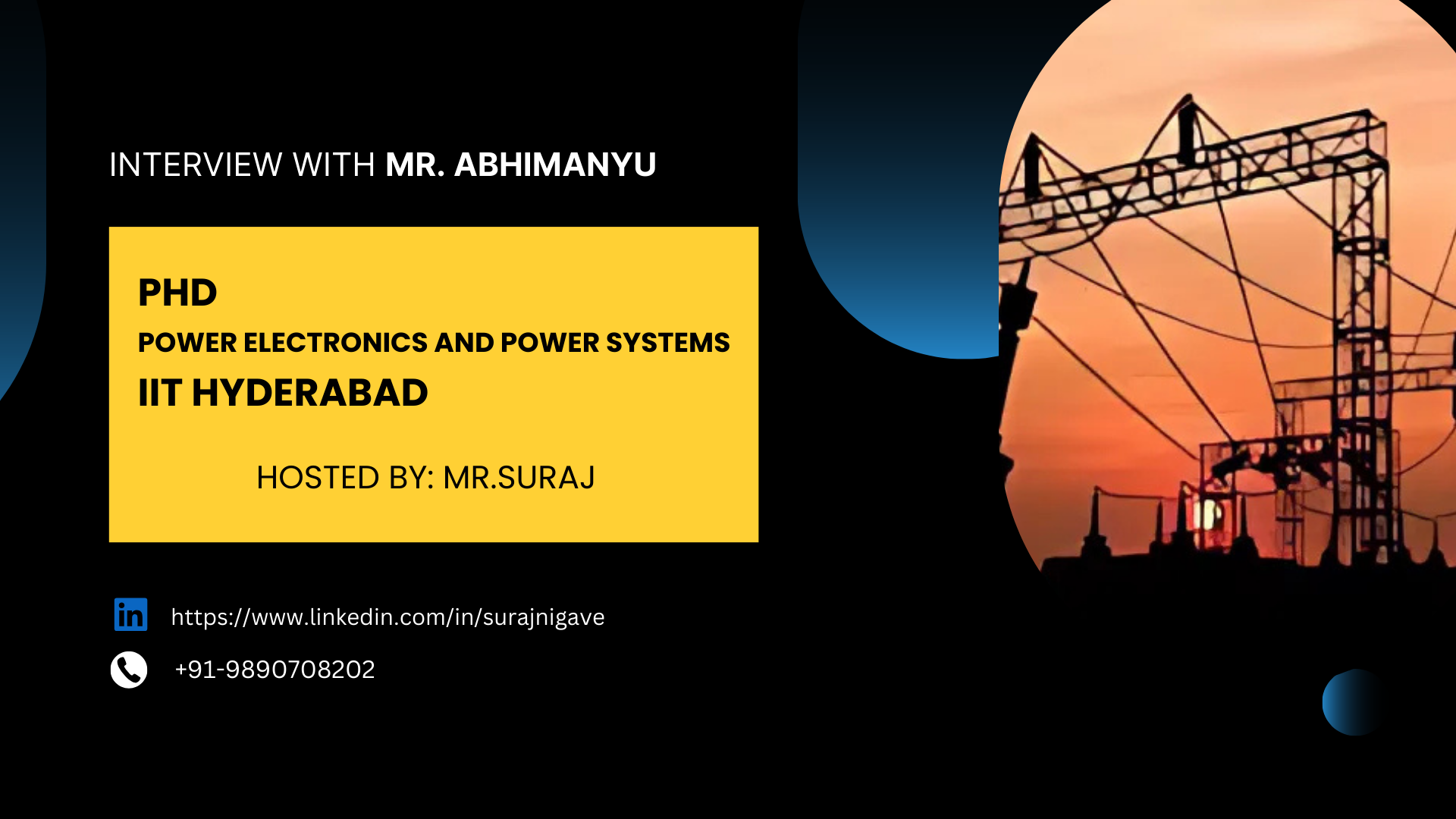Hello everyone! I’m currently pursuing my PhD in Power Electronics and Power Systems at IIT Hyderabad. In this blog, I want to share my experience and insights to help students who are exploring this field. I’ll discuss the core topics, the tools we use, and the types of projects that are most relevant today. My hope is that this guide will give you a clearer picture of what to focus on and how to build the skills that can open up exciting opportunities in the future.
Key Areas in Power Electronics and Power Systems
Power Systems Fundamentals:
In power systems, we deal with how electricity is generated, transmitted, and distributed. Some essential concepts include:
-
Short Circuit and Fault Studies: Understanding what happens when there is a fault or abnormal condition in the network, and figuring out how to isolate and fix it.
-
Load Flow Studies: Analyzing how power moves through the grid, ensuring that voltages and currents stay within safe limits and that the entire system runs smoothly.
Power Electronics Basics:
Power electronics is all about converting and controlling electrical energy efficiently. We use semiconductor devices and circuits to convert electricity from one form to another. For example:
-
DC to DC Converters: Increasing or decreasing a DC voltage level to match the needs of the load or the next stage in the system.
-
DC to AC Inverters: Converting DC power (often from renewable sources) into AC power so it can be fed into the grid or used by standard appliances.
Control Systems in Power Conversion:
Control systems ensure that our power converters and inverters work reliably, even if input or load conditions change. By measuring voltages and currents and then using microcontrollers or processors to adjust the operation of switches, we maintain stable output power. Control strategies can be simple, like using a Proportional-Integral (PI) controller, or more advanced, like using Model Predictive Control (MPC).
Integrating Renewable Energy
Renewable energy sources like solar and wind often produce DC outputs that vary with conditions like sunlight or wind speed. To connect them to the grid, we need to:
-
Understand the Source: Learn how solar irradiance or wind speed affects voltage and power output.
-
Use DC to DC Converters: Step up a low DC voltage from a solar panel to a higher DC voltage that can be more easily converted to AC.
-
Convert DC to AC with Inverters: Turn DC into AC so it can be synchronized and fed into the power system.
-
Maintain Stability and Control: As more renewable sources connect to the grid, the system may see rapid changes. We must design our controllers to respond quickly and keep the system stable under different operating conditions.
Electric Vehicle Charging and Bidirectional Operation
Electric vehicles (EVs) introduce another interesting application:
-
EV Charging: If we have an AC source at home, we need AC-to-DC conversion to charge the EV battery. In some cases, we might also need a DC-to-DC step-up or step-down stage.
-
Vehicle-to-Home (V2H) or Vehicle-to-Grid (V2G): EV batteries can also supply power back to the house or even the grid during emergencies or peak demand times. This involves running the inverter in reverse mode to convert DC from the battery into usable AC power.
These applications show how power electronics enable flexible and efficient energy management, especially as EVs become more common.
Understanding Inverter Topologies
DC to DC Converters:
-
Non-Isolated Converters: These do not have a transformer, making them simpler but offering less protection and smaller voltage gains.
-
Isolated Converters: These include transformers, providing safety, galvanic isolation, and higher voltage boosts. They are widely used in EV charging stations and in renewable energy systems.
DC to AC Inverters:
-
Two-Level Inverters: Offer two output voltage levels (for example, +Vdc and -Vdc).
-
Three-Level and Multi-Level Inverters: Provide more voltage levels, resulting in smoother, more sinusoidal output waveforms. However, more levels mean more switches and thus higher complexity and cost.
By choosing the right inverter topology, we balance performance, cost, efficiency, and complexity.
Software Tools and Simulations
Before building actual hardware, we rely on simulation tools to test our ideas:
-
MATLAB/Simulink: A popular tool for simulating power circuits, control strategies, and entire power systems.
-
PLECS and PSCAD: Software packages designed for analyzing power electronics and grid interaction cases.
-
LTSpice: Useful for circuit-level simulations with detailed component models, helping us choose the right parts and ensure proper circuit behavior.
After confirming our simulations, we often use real-time controllers like dSPACE to test our control algorithms in a hardware-in-the-loop environment before finally implementing them on physical microcontrollers and converters.
Practical Skills for Industry and Research
If you aim to work in industry or conduct advanced research, the following skills will help you stand out:
-
Master Simulations: Learn to use MATLAB, PLECS, or PSCAD effectively. Good simulation skills help you refine designs and avoid costly trial-and-error in hardware.
-
Hardware Prototyping: Understand how to select components, design circuits, and assemble test setups. Hands-on experience with gate drivers, LC filters, and transformers is invaluable.
-
Microcontroller Programming: Implementing your control algorithms on real hardware is key. Knowing how to write code for digital signal processors or ARM-based microcontrollers will make you highly valuable to employers and research teams.
Control System Modeling and Stability Analysis
Ensuring stability is crucial. We must model the entire system, including inverters, LC filters, transformers, and the grid itself. From these models, we design controllers that keep the system steady:
-
Linear Controllers: Such as PI or Proportional-Resonant (PR) controllers, are well-established methods.
-
Nonlinear Controllers: Advanced methods like hysteresis or model predictive control are gaining popularity because they can handle sudden changes more effectively.
To verify stability, we use tools from control theory, like root locus plots, Bode plots, and Nyquist diagrams. These techniques help us fine-tune our controller parameters and ensure the system operates reliably under varying conditions.
Advice for Students and Early Researchers
If you’re a student working on your Master’s thesis or a PhD in this area, keep the following points in mind:
-
Build a Strong Foundation: Make sure you understand the basics of power systems, power electronics, and control theory.
-
Practice with Simulations First: Start by simulating your ideas to gain confidence and understanding before moving on to hardware implementation.
-
Develop a Hands-On Approach: Try simple hardware projects at first. Learn how to handle real components and understand how converters behave outside the simulation environment.
-
Stay Curious and Adaptable: This field is evolving rapidly, with new converter topologies and control methods emerging regularly. Keep learning, experimenting, and staying updated with the latest research and industry trends.
Conclusion
Power electronics and power systems lie at the heart of many current and future technologies, from renewable energy integration to electric vehicle charging. By understanding the fundamentals, working with the right tools, and gaining practical experience, you can become a valuable contributor in this field. Whether you plan to enter industry, remain in academia, or pursue cutting-edge research, these skills will support you in making meaningful advances toward a more sustainable and efficient energy future.
I hope this guide gives you a clearer picture of what to study and what skills to develop. Keep exploring, stay motivated, and enjoy the journey as you build your expertise in power electronics and power systems!


























